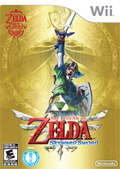
The Legend of Zelda: Skyward Sword
Published by Nintendo, Developed by Nintendo
US release date: - | EU release date: -
The best Zelda game since the N64 era.
Ever since details on The Legend of Zelda: Skyward Sword were released, it has been subject to an enormous amount of controversy. From the game requiring Wii Motion Plus and motion controls, to the game being another prequel, to being stylized in a similar fashion to The Wind Waker, there's been quite a bit of pressure facing Nintendo. Despite a few minor issues though, Skyward Sword has been beautifully handled, and in a way is the game many dreamed would be the standard for motion controlled titles.
It is difficult to talk about the story without getting into spoilers, but unless something drastic changes, Skyward Sword is very likely the last Zelda prequel for a variety of reasons. The game takes the first Link and Zelda, childhood friends, out of the skyward paradise of Skyloft and into a destiny that they could refuse, but would lead the world to ruin if they did. Many questions about the Zelda series in general are hinted at if not answered, but there is still no indication as to whether or not there is a definitive timeline. Still, there are ties to Wind Waker, Twilight Princess, Ocarina of Time and even Link's Awakening and fans will likely have a grand time finding everything. Most importantly, the players will learn how the Master Sword came to be and it's link (ha, ha) with the Triforce. The characters are mostly great, with each having a distinct look and attitude which results in the most memorable Zelda cast since Majora's Mask... with the possible exception of Fi, the 'spirit' of the Master Sword who has almost no personality to speak of.
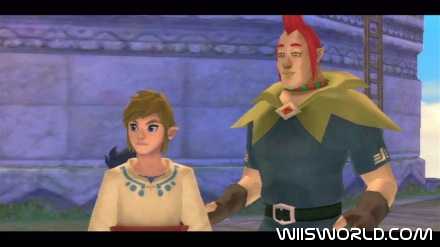 The traditional Zelda gameplay is the same overall, but there are many subtle changes which add up to a notable difference. Most noticeable is the abundance of motion controls, integrated far better than the tacked on controls of Twilight Princess. Players use the Wii remote (Motion Plus is necessary, sorry cheapskates) to skydive, fly their Loftwing, play musical instruments, swim underwater, balance on tightropes, and many more uses. Most importantly, combat takes on a whole new dimension with the ability to swing Link's sword in eight directions. This might seem like a gimmick at first, but the enemies constantly change tactics and strategies. At first, players will simply have to hit an enemy in a certain direction in order to damage them; later, they'll have to use specific items to fight with or look around the environment for what could be a weakness. The combat feels rewarding because the farther players get in the game, the more they'll see that the constant practice does pay off, and that enemies get easier not because of sword upgrades, but because of skill. Though occasionally the motion controls can lose alignment, this only happens maybe once every 90 minutes to two hours, and it's very easy to realign the remote. This seems to be an issue that varies between users, but this reviewer used a motion plus accessory and not built into the remote and there were rarely any problems. One thing to keep in mind is that one should take breaks if possible, not just to enjoy the game better but also because one's wrist can become very sore from prolonged remote usage.
The traditional Zelda gameplay is the same overall, but there are many subtle changes which add up to a notable difference. Most noticeable is the abundance of motion controls, integrated far better than the tacked on controls of Twilight Princess. Players use the Wii remote (Motion Plus is necessary, sorry cheapskates) to skydive, fly their Loftwing, play musical instruments, swim underwater, balance on tightropes, and many more uses. Most importantly, combat takes on a whole new dimension with the ability to swing Link's sword in eight directions. This might seem like a gimmick at first, but the enemies constantly change tactics and strategies. At first, players will simply have to hit an enemy in a certain direction in order to damage them; later, they'll have to use specific items to fight with or look around the environment for what could be a weakness. The combat feels rewarding because the farther players get in the game, the more they'll see that the constant practice does pay off, and that enemies get easier not because of sword upgrades, but because of skill. Though occasionally the motion controls can lose alignment, this only happens maybe once every 90 minutes to two hours, and it's very easy to realign the remote. This seems to be an issue that varies between users, but this reviewer used a motion plus accessory and not built into the remote and there were rarely any problems. One thing to keep in mind is that one should take breaks if possible, not just to enjoy the game better but also because one's wrist can become very sore from prolonged remote usage.
This is also one of the most tightly designed Zelda games ever. Though there are only seven 'dungeons' in Skyward Sword, there's a dearth of the filler that characterized even Ocarina of Time. There are no areas that are just made for the player to travel across, and though there are only four major locations in the game, they all have additional places to explore or change enough so that the 'travel' areas feel like mini-dungeons on their own. All of the puzzles on the player's way to the dungeon or boss are rarely frustrating and are based more on environment cues or clues than where a block is positioned. There are plenty of hints and rarely will players need a walkthrough if they simply experiment with the items they have. Even Link's sword plays a key role in a few unconventional puzzle and boss strategies, and while Skyward Sword does somewhat continue the tradition of one item being dominant in its dungeon, the designers at least tried to give each item more variety. Finally, the bosses are mostly very fun to fight, with the only exception being the incredibly easy third and sixth boss fights, and that mainly is because the sixth is simply the first boss recycled with a few new moves. With those exceptions, the bosses are similar to previous bosses, but will likely surprise the player with how tenacious they can be and how most bosses can prove to be very vicious. Like the puzzles, the bosses do require experimentation to defeat, and are never as cut and dried as one might think.
Skyward Sword also takes a major gameplay cue from Phantom Hourglass' Temple of the Ocean King and Twilight Princess' Tears of Light collection. Roughly half way through the game, Link must 'strengthen his spirit' by going into an alternate dimension called The Silent Realm. Visually it is similar to the Twilight Realm and involves the collection of various magic 'tears', spread across a limited area. Though players of PH and TP may be groaning in dismay, truthfully these areas are far better designed than those areas in the previous games and are rarely frustrating, even if the Silent Realm itself feels like an act of padding the game. In addition, a quest given near the end of the game does feel slightly like padding, but considering that this quest gives more new content and areas, it is a far better effort than the Triforce collection in Wind Waker.
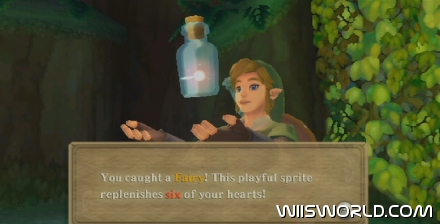 While many might still complain about having to play Wii games in Standard Definition, Skyward Sword's aesthetics admirably hide signs of age. Every area in the game is colorful and vibrant with a watercolor art style, achieving a great balance between the anime-inspired Wind Waker and the idealist look of Twilight Princess and Ocarina of Time. Each character and location is recognizable based on land and look, with the dungeons a highlight. The game's temples (Temples, not all of the dungeon areas) actually look real, with most of the inspiration taken from eastern Buddhist temples and places like Chinese water gardens for example. Of special note is the game's desert area, as once players discover this area's gameplay 'hook', a visual trick that manages to show two distinct areas at once is used, and the effect is stunning. All of this with little to no slowdown and responsive controls. The graphics do have some texture and blur issues, but considering that most game developers wish they could make games look this good, it's a negligible issue at most.
While many might still complain about having to play Wii games in Standard Definition, Skyward Sword's aesthetics admirably hide signs of age. Every area in the game is colorful and vibrant with a watercolor art style, achieving a great balance between the anime-inspired Wind Waker and the idealist look of Twilight Princess and Ocarina of Time. Each character and location is recognizable based on land and look, with the dungeons a highlight. The game's temples (Temples, not all of the dungeon areas) actually look real, with most of the inspiration taken from eastern Buddhist temples and places like Chinese water gardens for example. Of special note is the game's desert area, as once players discover this area's gameplay 'hook', a visual trick that manages to show two distinct areas at once is used, and the effect is stunning. All of this with little to no slowdown and responsive controls. The graphics do have some texture and blur issues, but considering that most game developers wish they could make games look this good, it's a negligible issue at most.
The sound is a bit of a mixed bag. While many might complain at the fact that the Zelda series still doesn't feature voice work, to be honest it might be for the best. While Nintendo of Japan and Europe might do a decent job of getting good voice actors, it would be terrible to have a Zelda game get the same shoddy treatment that Nintendo of America gave Metroid: Other M. On the positive side, Zelda has finally been given an instrumental soundtrack and most of it sounds incredible. While unfortunately most of the game's songs aren't catchy, none are bad, and there are at least five or six that will stay with players past the end credits. The instrumental themes of the original Zelda theme, Zelda's Lullaby and the iconic 'Master Sword' theme from Ocarina of Time are wonderful, and in some ways worth the whole package, but they don't appear as often as they should. A good soundtrack, just not great.
Skyward Sword is packed with content. In addition to the main game, which will likely take players about 35-40 hours to finish, there are a metric ton of side-quests. Goddess Cubes found on land can be used to open special treasure chests, bugs and materials can be used to optionally upgrade Link's potions and equipment and there are more than a few heart pieces along the way. The longest ongoing side activity involves helping out fellow Skyloft citizens for 'Gratitude Crystals' which can be exchanged for bigger wallets, heart pieces and items. There are more than a few mini-games and even a boss rush mode unlocked near the end of the game. Finally, the game features a Hero Mode, which is essentially hard mode but with some of the progress players made in the previous save.
The Legend of Zelda: Skyward Sword might turn off some people, whether they are fans of Zelda or not. Some have felt that the game's design feels too old, while others have complained that it doesn't feel like conventional Zelda. For those who are willing to try something that is somewhat new and just enjoy Skyward Sword for what it is, they'll likely love it. It reminded this reviewer of what joy can be had from a well designed interactive adventure that doesn't need kill-streaks, achievements or the latest DLC. Skyward Sword empowers, excites and stirs the imagination of those willing to enter its heights and proves why Zelda is still beloved after twenty five years.
Gameplay: 
Graphics: 
Sound: 
Lifespan: 
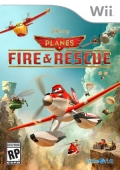 Planes: Fire & Rescue
Planes: Fire & Rescue
Disney
Released on November 6th, 2014
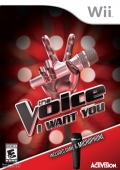 The Voice: I Want You
The Voice: I Want You
Released on October 21st, 2014
 Skylanders Trap Team
Skylanders Trap Team
Activision
Released on October 5th, 2014
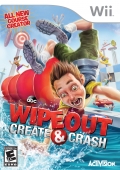 Wipeout: Create & Crash
Wipeout: Create & Crash
Activision
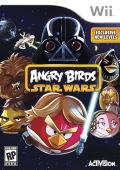 Angry Birds Star Wars
Angry Birds Star Wars
Rovio
Released on October 29th, 2013
gw117 said:
The download link doesn't work... ...
robcfg said:
I worked with those some years ago, and they are basically identical to the home unit, but it needed special recordable ...
samsopil1234 said:
Asia
... 50 Classic Games 3D
cocotg said:
cocotg* ... Cocoto Magic Circus 2
FellaHaterPeP said:
because they stink of poop
... Super Mario Odyssey
Wii's World is not officially affiliated with Nintendo! (but they wish we were).
User comments
No posts yet for this game. Posts make me happy.